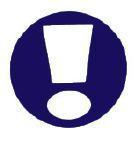SAS Urban Survival Handbook (40 page)
Read SAS Urban Survival Handbook Online
Authors: John Wiseman
Tags: #Health & Fitness, #Reference, #Survival, #Fiction, #Safety, #Self-Help, #Personal & Practical Guides, #General, #Survival Skills

Chronic poisoning may lead to a large number of varying disorders such as: dermatitis, asthma, regular headaches, respiratory complaints, cancers, circulatory problems, gastrointestinal illnesses.
A thorough medical check-up should be sought if you think you are at risk. You should examine yourself regularly and decide whether you are taking the proper precautions when dealing with chemicals. Even at work, safety procedures may be inadequate—or you may be especially sensitive to a particular substance.
MAJOR RISKS
Look at the labels of products that you buy for the home. Read the warnings and obey all instructions. Exceed the precautions if you can.
Labelling of products for home use is strictly regulated. You know that, if a specific chemical is named, you are dealing with a potentially-dangerous preparation. The absence of specific chemical names should not be taken to mean that the product is safe. Danger lies in thinking that things you can buy for home use—especially medicines—must be safe.
You may be so familiar with a product, that you don’t bother to read the label at all. There ARE warnings on most toilet cleaners, for instance, NOT to mix them with any other cleaning agents. A violent reaction might take place, producing choking toxic fumes.
Symbols have been developed to help you recognize hazardous substances at a glance.
PLEASE NOTE
The exclusion of any type of household chemical or medicine from the following lists should not be taken as an indication that such products are safe. Almost any chemical can be dangerous, if used without caution. The following represents some of the most common dangers in the home. Use the EMERGENCY! panels for first-aid information and guidance.
▶
Use these EMERGENCY! panels (particularly for skin and eye contact) as a guidance throughout this section.

EMERGENCY!
CHEMICAL HAZARDS
- ▶
SKIN AND EYE CONTACT
Skin contact 1:
Wash off as soon as possible with soap and warm water. Don’t scrub.
Skin contact 2:
As 1, but rinse the skin for several minutes to be sure all traces of chemical are removed or diluted. If area of skin affected is large or becomes sore or a rash develops, seek medical attention.
Skin contact 3:
As 2, but rinse area for at least 20 minutes under running water. There might be ‘burns’—seek medical attention.
IF CLOTHING IS CONTAMINATED
with caustic chemicals, solvents or pesticides, remove it and wash affected skin but don’t allow the casualty to get cold.
Eye contact 1:
Rinse out the eye (with the lid held open) with cool running water for a few minutes. As soon as the eye irritation settles down, you may need to seek medical attention.
Eye contact 2:
As 1, but don’t waste any time. Rinse out the eye for at least 20 minutes. Hold a soft cotton pad over the eye gently and seek medical attention.
IRRIGATING THE EYES must be done under a tap. Cold water will do but may be uncomfortable. Hot water will NOT do. Try to get to a mixer tap, to get a gentle flow at about blood temperature—this is less unpleasant. A shower attachment may make the job easier. Even a bowl of clean water splashed into the eye for a while will help. The process may be very traumatic for children or the elderly. Do the best you can and seek medical assistance as soon as possible.
NOTE:
In industry where goggles may not be possible, but eyes may be at risk, it is common to have a bottle of eye-washing solution fitted with its own eyebath top. If you can find something like this to keep in the home for emergencies, it would be sensible.

EMERGENCY!
CHEMICAL HAZARDS
▶
INHALATION: GUIDELINES
Take dizzy or nauseous casualty to fresh air. Loosen restrictive clothing. If symptoms don’t subside in a few minutes, seek medical attention. Otherwise, keep casualty calm and warm.
IF CASUALTY IS VERY DIZZY, HAS SLURRED SPEECH, OR VOMITS
Place in recovery position, to keep airway open. Cover to keep warm and call an ambulance.
▶
INGESTION: GUIDELINES
Small amounts of simple household chemicals may do no harm. Observe casualty for some time, give milk or water to sip slowly and seek medical attention if there is any discomfort or distress.
DO NOT INDUCE VOMITING.
IF CHEMICAL IS HIGHLY TOXIC
Even small amounts may be dangerous.
Wipe away chemical from skin with water—especially if substance is caustic.
Seek medical attention as soon as possible.
If obviously serious, call an ambulance.
IF A LARGE AMOUNT OF CHEMICAL IS SWALLOWED
If larger amounts have been swallowed, almost any chemical may be dangerous. Keep casualty calm. Call an ambulance.
IF CASUALTY IS UNCONSCIOUS, BUT BREATHING
Place in recovery position, to keep airway open. Cover casualty to keep warm and call an ambulance.
BE PREPARED FOR CONVULSIONS OR VOMITING
If fits or convulsions take place, don’t let the casualty hurt themselves—particularly protect the head. If vomiting occurs in a semi-conscious or conscious casualty, they may choke.
IF HEARTBEAT/BREATHING STOPS
Be prepared to give cardiac compression and artificial respiration. With a small child, place your mouth over the mouth and nose of the casualty. Avoid the risk of poison around the casualty’s mouth.
REMEMBER
Everyone who looks after children, the elderly or anyone with a recognized medical condition, should keep a note of emergency phone numbers—including a doctor and the nearest hospital. It may be necessary for you to take a person to the nearest casualty department or emergency room at a hospital. Do you know where it is? If you do a lot of DIY, are a crafts enthusiast, or use a lot of chemicals in the home or garden, you should know what to do in an emergency.
Acids in the home
 Acids are common as constituents of many domestic cleaning products such as de-scalers (limescale removers), toilet cleaners, drain clearers—even car batteries contain fairly strong acid.
Acids are common as constituents of many domestic cleaning products such as de-scalers (limescale removers), toilet cleaners, drain clearers—even car batteries contain fairly strong acid.
Plumbers are fond of ‘spirits of salt’—it cleans metal very quickly. Some people use it to kill tree stumps or clean stoneand quarry-tile floors. It is actually a 32 per cent solution of hydrochloric acid, which produces toxic choking fumes.
If a product contains any named acid, follow directions very carefully, avoid skin contact and DON’T mix with other preparations. Most acids are very caustic and cause burns to human tissue and often choking acrid fumes.
See EMERGENCY! panel: Skin contact 3/Eye contact 2. DO NOT INDUCE VOMITING
Alkalis in the home
 These include sodium hydroxide (caustic soda), sodium hypochlorite, ammonia, potassium hydroxide, calcium oxide—in fact, any caustic or heavy-duty cleaning product which does not contain a named acid is likely to contain a powerful alkali. Like acids, most produce burns on human tissue and sometimes choking fumes. They are common in bleaches, toilet cleaning products, paint strippers, oven cleaners.
These include sodium hydroxide (caustic soda), sodium hypochlorite, ammonia, potassium hydroxide, calcium oxide—in fact, any caustic or heavy-duty cleaning product which does not contain a named acid is likely to contain a powerful alkali. Like acids, most produce burns on human tissue and sometimes choking fumes. They are common in bleaches, toilet cleaning products, paint strippers, oven cleaners.
See EMERGENCY! panel: Skin contact 3/Eye contact 2. DO NOT INDUCE VOMITING
Solvents in the home
 Solvents are used in numerous products, from paints to glues, spot/grease removers to dry cleaning chemicals, aerosols to paint thinners, brush cleaners to nail varnish. They evaporate rapidly, even at low temperatures. The vapours are toxic and can quickly make you dizzy or nauseous.
Solvents are used in numerous products, from paints to glues, spot/grease removers to dry cleaning chemicals, aerosols to paint thinners, brush cleaners to nail varnish. They evaporate rapidly, even at low temperatures. The vapours are toxic and can quickly make you dizzy or nauseous.
It is not safe to drive or operate machinery if affected. They are readily absorbed into the body where they melt fats and damage tissues.
Long-term exposure risks are liver and kidney damage. Even short-term exposure may cause memory loss and disturbed concentration. Overexposure may cause headaches, vomiting, stupor or even hallucinations. Emergency treatment is required.
See EMERGENCY! panel: Skin contact 1 or 2/Eye contact 1. DO NOT INDUCE VOMITING
REMEMBER
Ventilation when working is top priority. If your job involves the use of solvents, you should be properly protected and have regular medical check-ups to ensure you are not suffering long-term effects.
 WARNING
WARNING